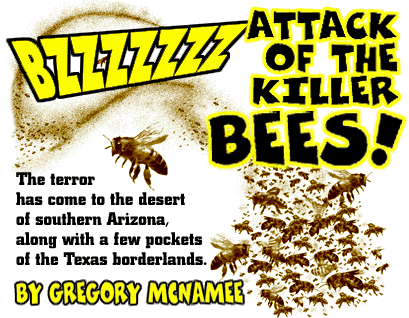|
Edited on Thu Jul-19-07 10:44 AM by IanDB1
GLIDE Number: AA-20070719-12432-USA Date / time: 19/07/2007 09:25:26
Event: Animal Attack
Area: North-America
Country: USA
State/County: State of Texas
City: Killeen
Number of Deads: None or unknow
Number of Injured: None or unknow
Damage level: Minor

Description:
Central Texans should keep a watchful eye over more than just the SPF level of their sunblock this summer. Swarms of bees have taken to a late-season breeding schedule across the area after the heavy rains. Several swarms of bees were discovered Monday on a fire hydrant along Greengate Drive in northeast Killeen and last Sunday, a Lampasas family was attacked by a swarm of thousands of Africanized honey bees, often referred to as "killer" bees. Sgt. Tony Barrio of the Lampasas Police Department responded to the scene of an angry swarm that chased after a father, mother and their son as they attempted to flee in their SUV. The parents had to be hospitalized, but the 2-year-old, strapped in the back seat, was unharmed.
"Once EMS arrived on scene, they realized it wasn't a typical bee sting; it was actually a bee attack," Barrio said Wednesday. "I sent a patrol over there. I was trying to contact him, but I didn't realize that he couldn't respond because he was under attack, too. Once I heard that, I ran on over there with the fire department." Barrio said the couple stopped on the side of the road to look at a home for sale when their SUV suddenly was swarmed by thousands of angry bees that poured like a black pillar from an old tree hollow nearby. As the bees overwhelmed the couple, they hopped inside their vehicle and attempted to speed away. But because the windows were left down, the bees filled the interior of their Ford Excursion, and covered the faces and eyes of both adults. The man stopped the SUV and ran more than half a mile down the road to call for help.
"They tried to drive away, but the bees swarmed inside the vehicle," Barrio said of the scene shortly before he and emergency services personnel arrived. "The female got sleepy as she tried to get to the infant, then became disoriented and passed out on the street. EMS personnel managed to rescue her and get her into an ambulance." They also rescued the toddler. Barrio said the scene resembled something out of a cheesy horror movie. "The fire department arrived and saw a lady in the street and the infant in the vehicle covered in bees," he said. "Our fire marshal went in and pulled the infant out and put them both in the ambulance. " The swarm then followed the emergency trucks. The fire department attempted to subdue the bees, spraying two of its hoses at the hollow as the swarm continued to emerge: a large, black column of twisting anger. "I've been doing this 17 years, and I've never seen an attack like that," Barrio said. "I've been on a lot of bee calls, and I've never been aggressively pursued by bees. The fire department put a thousand gallons of water down that tree and hit it with two hoses." He said the water didn't slow the bees' attack down much. "At that point, we sealed off the street for a half a mile." EMS personnel transported the family to Rollins-Brook Community Hospital in Lampasas. The man sustained more than 100 stings, while the woman received more than 500. The man was released from the hospital on Sunday, and the woman was released on Monday.
Entomologist Alexis Park at the University of California-Riverside studies the swarming behavior of European honey bees, the kind seen most often in the U.S. He said that the swarming behavior is natural for all bees, both Africanized and European, and functions as part of their natural reproductive process. "The swarm is a natural part of honeybee lifestyle. They often leave and make a new nest," Park said. "That is a swarm that has left the parent colony. Most swarms are very docile because there are no food stores; they aren't protecting young bees." Park believes that the Lampasas family unknowingly disturbed the parent colony of Africanized honey bees. A construction area ripe with unexplored openings makes an ideal location for a hive, he said. "In the case of honey bees, reproduction happens with the hives as a group, not as individuals," Park said. "The swarm on the hydrant is likely an old queen who brought a bunch of her followers with her and left the parent colony behind. She'd leave several queens behind to fight for control." Beekeeper Clint Walker, owner of Walker Honey in Rogers, said that since Africanized honey bees can swarm, or produce a new bee colony, as many as 16 times in a single year, compared to once a year for European honey bees, the danger this time of year is still very real.

More:
http://hisz.rsoe.hu/alertmap/woalert_read.php?lang=eng&cid=12432 |